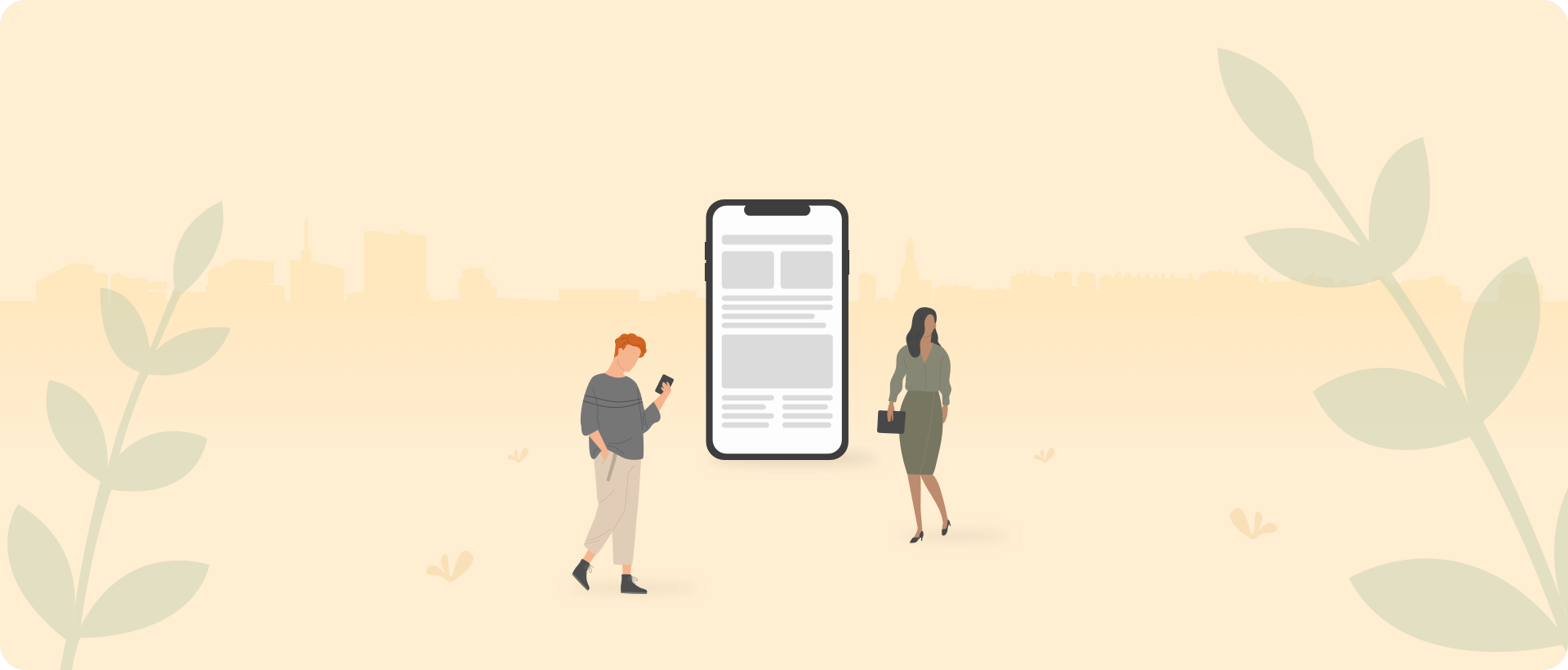Before switching to Harver, many of our retail clients were using out-of-the-box pre-employment assessments to evaluate the competency of prospective hires, mostly because of convenience and ease of use.
Although these generic solutions are immediately available, they carry disadvantages that shouldn’t be overlooked. For example, they cannot accurately evaluate if a candidate fits the company culture, and fail to set realistic expectations for what the job entails.
In this article we’ll focus on the types of pre-employment assessments that work best for high volume retail recruitment and the science behind them, to help you make unbiased, data-driven hiring decisions.
What’s in?
What types of pre-employment assessments work best for retail?
When retail recruiters dealing with high volumes of applicants look only at the current job situation to get a feel for why employees are leaving, they see only half of the picture.
To really understand why retail new hires leave, we should take a step back and look at the full picture, starting with the selection process.
We’ve covered this topic thoroughly in our Candidate selection e-book, so we won’t focus too much on how to improve the process right now. If you’re interested in the topic, you can download the e-book below.
Stop guessing,
Start data-driven hiring.
Learn how you implement a modern candidate selection process, that is: streamlined, experience-driven and backed by data.

Decreasing employee attrition in high volume retail companies starts with tweaking the hiring process to move only the best-suited candidates to the interview stage.
With the above in mind, there are three common assessment types we recommend to our retail clients who deal with mass hiring.
Situational judgement tests (SJT)
Situational judgement tests are the most common type of pre-employment assessments we use for high-volume retail hiring. These assessments take between 8-12 minutes for candidates to complete and include situational questions tailored to the role.
For example, candidates who apply for low-entry jobs in grocery stores might be shown a video where a customer asks for their help while they restock the shelves.
The candidate is then prompted to choose the best way to handle the situation, from a list of three possible answers. These potential answers are ranked most effective to least effectual, and they help assess the candidate’s customer orientation, their service or sales skills.
Applicants’ answers are scored and compared to employer-specific benchmarks for the appropriate reactions to those realistic job scenarios.

Situational judgment tests not only evaluate the applicant’s fit for the job, but they also help the candidate understand what their day-to-day role will look like, in practice.
Why is this important?
Because in 60% of the cases, new hires leave a company when their expectations for the role aren’t met. And this may not sound like a huge problem, since the labor market right now is quite good for employers. However…
It costs about a third of an employee’s annual salary to replace and train a new hire.
– C&D Restructure and Taxation Advisory
It’s worth noting that SJT’s can evaluate a wide range of core skills, from stress resistance and customer orientation, to multi-tasking and sales skills. For instance, employers can see how candidates handle stressful situations, like dealing with angry customers in long waiting lines.
An SJT’s content depends on the client profile. On the one hand, you have supermarkets hiring floor workers. Here you may only need to evaluate for necessary skills. For instance, stacking shelves and rudimentary customer service.
On the other hand, you have luxurious department stores where customers want to know the finer details about the products they’re purchasing. As such, while the platform and assessment type remains the same, the questions and content need to differ accordingly.
For this reason, when we create custom pre-employment assessments for our high volume retail clients, we start by looking at the job families they are hiring for.
We’ll detail our process and approach to developing custom assessments in the next sections of this article.
Like what you see?
Don’t miss out. Subscribe to our quarterly digest to get the latest TA and TM resources delivered right to your inbox.
Personality tests
Personality tests ensure a good fit with the company culture, as they’re designed to reveal the candidate’s dominant personality traits.
How this works in practice is that the employer first tells us what the desirable characteristics and qualities representing an excellent cultural fit are.
From there, we design questions to identify these traits in candidates. For example, suppose teamwork is one of your core business values. In that case, your personality test might ask how much candidates enjoy working with others and how easy they find fitting into a new group.
Often, personality tests aim to determine the following:
- Communication skills
- Teamwork skills
- Resistance to stress and conflict
- How sociable the candidate it
- The candidate’s aptitude for customer-facing roles
- How candidates perform under pressure
- How easily candidates get bored or lose motivation
- How candidates respond to leadership
With so much riding on your pre-assessments, it’s imperative they’re effective. Otherwise, employees often find themselves stranded in a job that doesn’t suit them, and unsurprisingly, they usually leave. This, of course, results in your store suffering from high staff turnover.
This is why custom pre-assessments are worth their weight in gold. They’re proven to increase the quality of hire, reduce attrition and enhance the candidate experience.
At Harver, we have a People Science team that takes a scientific approach to developing pre-employment assessments for high volume retail roles.
If you’d like to see how Haver can transform your hiring process,
book a demo here!
Creating assessments yourself vs. out-of-the-box solutions
When it comes to volume hiring within the retail industry, many roles boast similar criteria. Often, this makes it possible for out-of-the-box solutions to adequately measure candidate suitability.
That said, ready-made assessments frequently leave unexpected holes in their evaluations. For example, it’s not uncommon for these kinds of solutions to fail to identify the hire’s likelihood of clashing with the workplace culture later down the line.
In contrast, a pre-built solution tailored to meet your business’s needs provides a more holistic evaluation. Namely, by your business’s infrastructure, processes, products, customers, and, of course, workplace culture.
We’ve seen our retail clients experience significant improvements in their key recruitment metrics – time to hire and cost of hire, attrition rate, assessment completion score and candidate satisfaction score. Here are some of our results.
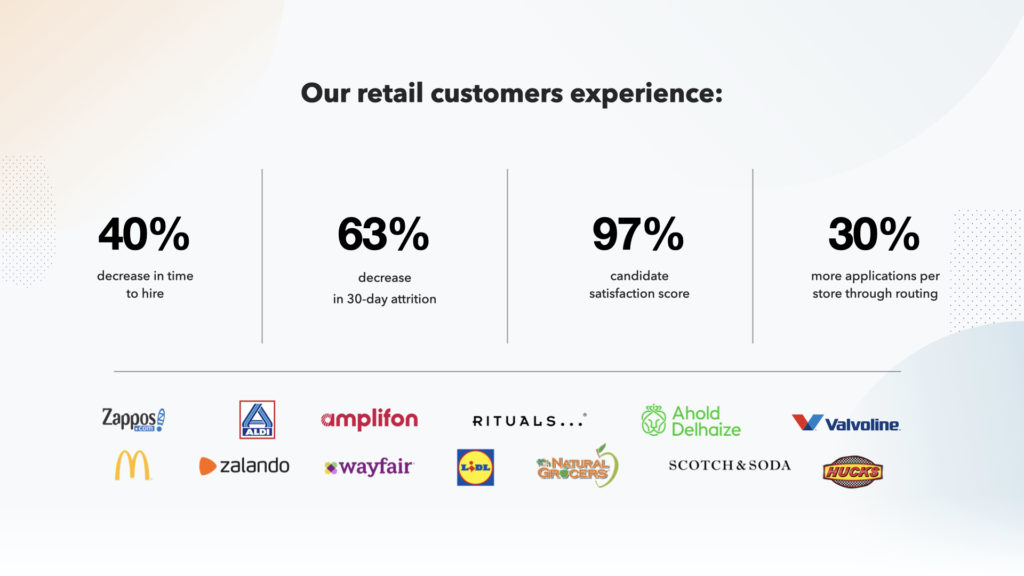
The advantages of custom pre-employment assessments
A lot of our retail clients approach us because they’re searching for a solution to help them hire better people faster and in a scientifically-validated manner.
In most cases, they already have an SJT solution in place, but it’s an out-of-the-box set of questions that doesn’t take into consideration the specifics of the job or the company culture.
So when we start exploring the options, most of them show interest in custom-made assessments, including company videos that showcase the culture and realistic job previews that help applicants understand the real nature of the role being advertised.
We therefore think it’s important to consider the advantages below when having to choose between custom-made and out-of-the-box pre-employment assessments.
Accurately reflect the role and company culture
As we’ve already hinted at, custom pre-assessments can accurately measure your candidate’s skills for any given position. In retail, simple situational judgment tests (SJT) are commonly used to assess whether candidates understand the role’s requirements.
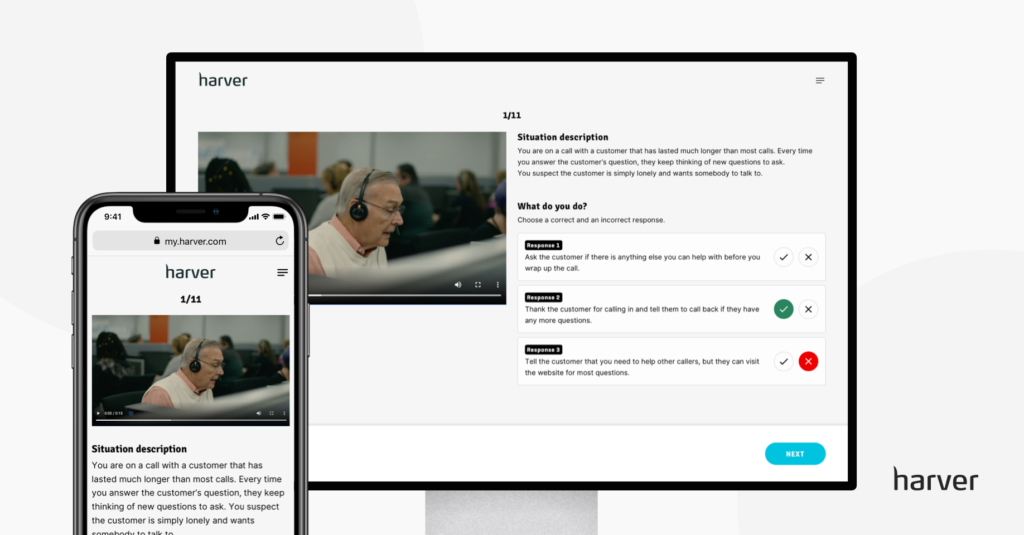
However, we work with the employer to ensure assessments consider the skills and personality traits candidates need to thrive in the job role they’re hiring for within the workplace culture.
The employer’s input empowers our People Science team to tailor the evaluation flow to reflect the job’s reality. This ensures candidates receive an accurate preview of what it’s like to work at that company.
That way, successful candidates can accept or reject your job offer with their eyes wide open, which goes a long way to boosting staff retention.
No superfluous assessments
As we create a bespoke solution for your business, we only measure skills that correlate with job performance.
In comparison, out-of-the-box solutions might evaluate candidates for skills irrelevant to the role you’re hiring for. Not only is this a huge time waster, but it can send mixed signals to candidates about what the role entails.
Better candidate experience
Instead of just sending in a resume, candidates benefit from a short experience that provides an insight into the job role and workplace culture. This empowers them to decide whether they would enjoy working for your company.

At this stage, many candidates who wouldn’t be a good fit remove themselves from consideration. This straightforward and intuitive process often results in a better candidate experience and higher candidate satisfaction scores.
Now, a common question we receive during the discovery calls with high volume retail customers is how detailed or how long these assessments should be.
Let’s discuss the topic a bit more in-depth, to make sure you have a good understanding of how we approach this.
Measure relevant skills based on KPIs
Unlike generic assessments, company-specific ones allow you to track and measure the metrics that are relevant for your organization and for the specific vacancy.
For example, if you’re hiring for a customer support role, you might want to see not only how well the candidate handles stressful situations, but also how many tickets he or she can solve per hour or day.
The Harver pre-employment assessments are developed to test characteristics that are predictive of high performers based on the organization’s benchmarks and work environment.
The metrics are collected in a centralized dashboard where all the candidate data is easily visible. As a result, recruiters can make objective decisions in a timely manner, while keeping KPIs in mind.
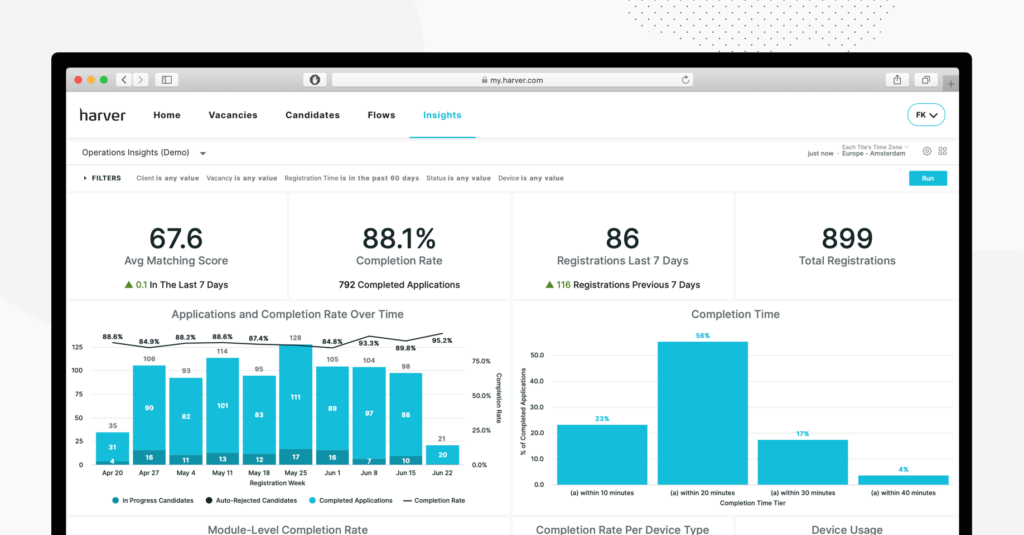
How many assessments should you use for high volume retail jobs?
When an application process takes too long or feels overly complicated, even the best-suited candidates might drop out and lose interest. For example, we’ve seen assessments that take more than a few minutes to go through, and the drop-off rates tend to be higher.
This is understandable, since people applying for low-entry retail jobs usually want to get hired as soon as possible, and are less concerned with career projections. The most effective way to keep them engaged is to keep the assessments short and to the point.
In light of that, we typically include around 12 questions in SJTs. As such, they take around 8-12 minutes to complete, although the time investment varies depending on the types of assessments you opt for.
For example, if you want to include video SJTs, a company video that shows the work environment, as well as a video pitch module, then the assessment might take a bit longer to complete.
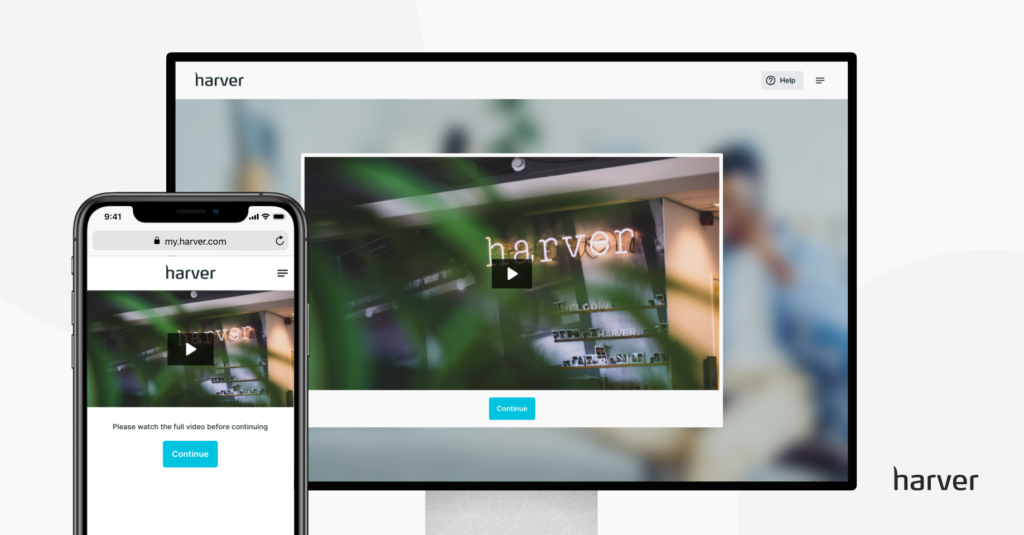
On the other hand, personality questionnaires can take much longer, as they ask about the candidate’s preferences at length. Adding these to your pre-employment screening process can be valuable when the labor market is good, but if the market is tight, you might want to decrease friction by choosing fewer tests.
Having said that, more comprehensive assessments are excellent for testing a candidate’s motivation. With a recent rise in retail job applications, retailers often consider these dropouts ideal for sifting out the most motivated and interested candidates.
What does the process look like for you, the employer?
Now let’s flip the script and explore what creating a custom retail pre-employment test looks like for you, the employer.
We follow a specific framework to make sure we understand your company culture precisely and that the assessments that we create together are the most relevant ones for the vacancies you have open.
In big lines, our process includes the following activities.
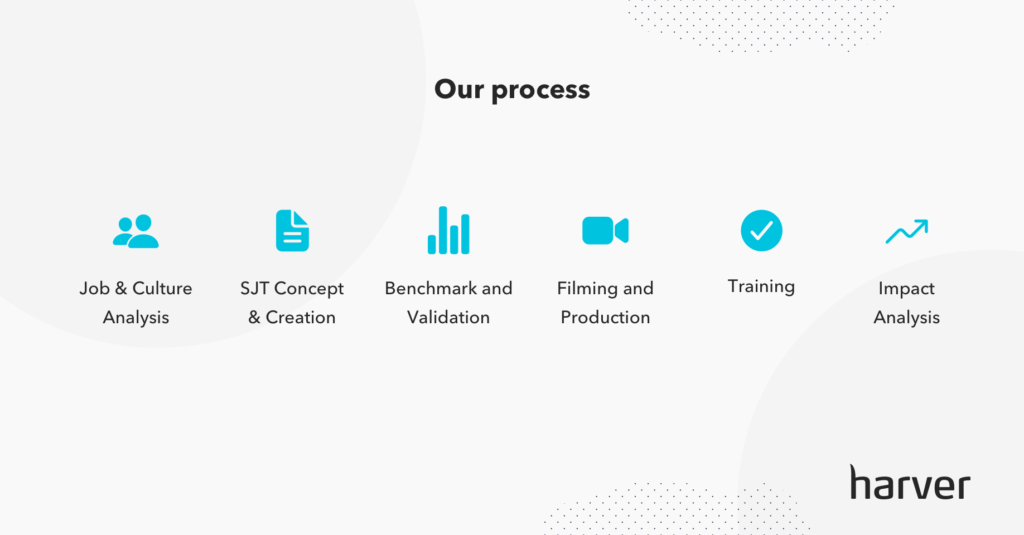
Here’s a brief overview of the main activities involved in each milestone.
Job and culture analysis
We engage you in a series of workshops meant to help us understand your organization and the roles you’re hiring for. Then, we build an assessment flow that measures key competencies important for success.
Our People Science team works together with your subject matter experts to determine cultural aspects, key functions and tasks, as well as key competencies that can help us differentiate high and low performers.
Together, we identify critical situations that should be included in the SJTs, as well as the best and worst way of responding. At the end of this step, we consolidate all the findings and map the essential tasks for the next stage.
SJT concept creation and development
During this step, we incorporate the findings from the SME job and culture session as well as your brand guidelines into an initial concept for the situational judgement tests.
We present this to your team and align on the overall style and content, then we draft the questions for the assessments. The SJTs are tested with your employees to identify 10-15 questions that are more relevant for the benchmark validation study.
Finally, we align the style, storyline and SJT questions to test in the validation study. This enables us to provide a stellar candidate experience including a realistic job preview and SJTs predictive of success.
Benchmark validation process
The goal of this step is to provide a fully validated assessment flow and to identify a matching algorithm predictive of key KPIs.
For this, we collect performance data that includes a representation across different performance levels, and we analyze the test results to identify specific assessment items and scores correlating to key metrics.
Based on this, we select the final SJTs for your recruitment process. At the end of this step, we’re ready to proceed with filming and production.
Filming and production
It’s time to bring the candidate experience to life in line with the concept creation and to make this fun for both your team and your potential candidates!
We develop a storyline and script, decide on the best location for filming, select actors – they could even be your employees! – and then start filming. At the end, we edit the videos, incorporating your feedback, and deliver the finalized videos that you can add to the candidate assessment flow.
Evaluating the effectiveness of assessments
Last but not least, you’ll need to evaluate the effectiveness of your pre-employment tests. Here are our general guidelines and the process that we usually follow.
Implementing and assessing the pre-employment screening
Once the pre-employment assessment is approved, the next step is to ready the platform, integrations, and videos. With all that done, it’s time to go live!
Once you’ve conducted the assessments, you can get insights into the results from your dashboard.

On top of that, Harver performs and presents an impact analysis. This measures how the assessments have affected attrition and performance as time goes on. We also assess the candidate experience for candidate satisfaction.
Adjusting assessments post-launch
It’s rarely necessary to redo an assessment. However, depending on how competitive the job market is, it can help to shorten the assessment process to avoid high drop-off rates.
When there’s an increased number of jobs available in retail, candidates often have a wide range of employers to choose from. In climates like this, candidates are more likely to ignore an assessment that’s too lengthy. Consequently, the assessment might need adjusting accordingly.
All in all, it may seem like a complex process, but if we look at the results of our clients, it’s quite clear that the long-term benefits are worth the investment!
Albert Heijn improved candidate satisfaction by 87% using Harver’s assessments!
And here’s what their new hires had to say about the application procedure.
“Applying was very easy, and afterwards I had a rough idea of what working at every department would be like. I got a text almost instantly and was hired two days later.” (Albert Heijn Candidate)
You can read their success story below.
Next steps: see Harver’s pre-employment assessments in action
With custom pre-employment assessments, volume-hiring for retailers can be made much more effective. These work wonders for helping you identify better quality candidates and improving attrition rates in the long run.
Harver’s pre-employment assessments have helped clients like HEMA transform their selection process. They drastically reduced the time it took to hire across 800 stores by giving managers the ability to predict a candidate’s success.
If you’d like to see what our solution can do for you, schedule an intro call with our team below!
Ready to transform your hiring process?
